
(a)
Interpretation:
Among the given pair of compounds, which compound has the polar pi bond that will undergo nucleophilic addition more rapidly is to be identified and explained.
Concept introduction:
A Nucleophilic addition reaction involves a polar
Answer to Problem 17.34P
Among the given pair of compounds, the second compound has the polar pi bond that will undergo nucleophilic addition more rapidly than the first one. This is because with fewer alkyl groups attached to the carbonyl carbon, there is less bulkiness and greater concentration of positive charge.
Explanation of Solution
The given pair of compounds are
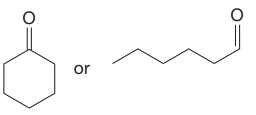
The electron-donating groups attached to the carbonyl carbon will decrease the concentration of the positive charge on the carbonyl carbon atom. In the first compound, the carbonyl carbon has two electron-donating substituents attached. In the second compound, the carbonyl carbon has only one electron-donating substituent attached. The partial positive charge on the carbonyl carbon of the second compound is greater as compared to the first one. This makes the carbonyl carbon of the second compound more electrophilic, thus, it will have more polar pi bond. Due to this, it will undergo nucleophilic addition reactions more rapidly. Due to fewer alkyl groups attached in the second compound, there is less bulkiness and hence greater contribution of a positive charge.
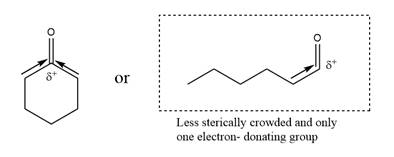
Electron-donating groups directly attached to the carbonyl carbon will decrease the concentration of a partial positive charge and make the pi bond less polar.
(b)
Interpretation:
Among the given pair of compounds, which compound has the polar pi bond that will undergo nucleophilic addition more rapidly is to be identified and explained.
Concept introduction:
A Nucleophilic addition reaction involves a polar
Answer to Problem 17.34P
Among the given pair of compounds, the second one has a more polar pi bond that will undergo nucleophilic addition more rapidly than the first one. This is because a substituent -
Explanation of Solution
The given pair of compounds are
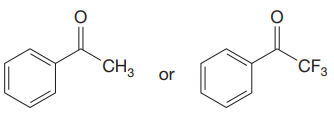
The electron-withdrawing groups attached to the carbonyl carbon will increase the concentration of the positive charge on the carbonyl carbon atom. In the first compound, the carbonyl carbon has a benzene ring at one end, and a
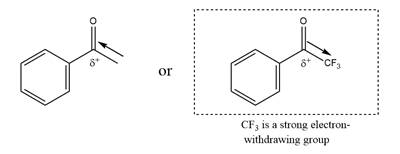
Electron-withdrawing groups directly attached to the carbonyl carbon will induce a greater concentration of a partial positive charge and make the pi bond more polar.
(c)
Interpretation:
Among the given pair of compounds, which compound has the polar pi bond that will undergo nucleophilic addition more rapidly is to be identified and explained.
Concept introduction:
A Nucleophilic addition reaction involves a polar
The concentration of the positive charge on the carbonyl carbon increases as the distance between an electron-withdrawing atom or group and the carbonyl carbon decreases.
Answer to Problem 17.34P
Among the given pair of compounds, the first one has more polar pi bond that will undergo nucleophilic addition more rapidly than the second one. This is because with the chlorine atom closer to the carbonyl carbon, the carbonyl carbon will bear a greater concentration of positive charge.
Explanation of Solution
The given pair of compounds are
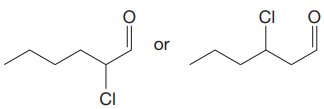
Among the given pair of compounds, the first one has more polar pi bond that will undergo nucleophilic addition more rapidly than the second one. This is because with the chlorine atom closer to the carbonyl carbon, the carbonyl carbon bears a greater concentration of positive charge. The partial positive charge on the carbonyl carbon of the first compound is greater as compared to the second one. This makes the carbonyl carbon of the first compound more electrophilic, thus, it will have more polar pi bond. Due to this, it will undergo nucleophilic addition reactions more rapidly.
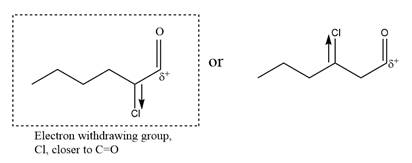
The concentration of the positive charge on the carbonyl carbon increases as the distance between an electron-withdrawing atom or group and the carbonyl carbon decreases.
(d)
Interpretation:
Among the given pair of compounds, which compound has the polar pi bond that will undergo nucleophilic addition more rapidly is to be identified and explained.
Concept introduction:
A Nucleophilic addition reaction involves a polar
Explanation of Solution
The given pair of compounds are:
![]()
Among the given pair of compounds, the first one has more polar pi bond that will undergo nucleophilic addition more rapidly than the second one. This is because the nitrile carbon bears a higher concentration of positive charge owing to the presence of the electron-withdrawing


Electron-withdrawing groups directly attached to the pi bond will induce a greater concentration of a partial positive charge and makes the pi bond more polar.
[DK1]
Want to see more full solutions like this?
Chapter 17 Solutions
EBK GET READY FOR ORGANIC CHEMISTRY
- CH, CH CH₂ CH₂ Phytyl side chain 5. What is the expected order of elution of compounds A-D below from a chromatography column packed with silica gel, eluting with hexane/ethyl acetate? C D OHarrow_forwardPlease analze my gel electrophoresis column of the VRK1 kinase (MW: 39.71 kDa). Attached is the following image for the order of column wells and my gel.arrow_forward2.0arrow_forward
- Write the electron configuration of an atom of the element highlighted in this outline of the Periodic Table: 1 23 4 5 6 7 He Ne Ar Kr Xe Rn Hint: you do not need to know the name or symbol of the highlighted element! ☐arrow_forwardCompare these chromatograms of three anti-psychotic drugs done by HPLC and SFC. Why is there the difference in separation time for SFC versus HPLC? Hint, use the Van Deemter plot as a guide in answering this question. Why, fundamentally, would you expect a faster separation for SFC than HPLC, in general?arrow_forwardA certain inorganic cation has an electrophoretic mobility of 5.27 x 10-4 cm2s-1V-1. The same ion has a diffusion coefficient of 9.5 x 10-6cm2s-1. If this ion is separated from cations by CZE with a 75cm capillary, what is the expected plate count, N, at an applied voltage of 15.0kV? Under these separation conditions, the electroosmotic flow rate was 0.85mm s-1 toward the cathode. If the detector was 50.0cm from the injection end of the capillary, how long would it take in minutes for the analyte cation to reach the detector after the field was applied?arrow_forward
- 2.arrow_forwardPlease solve for the following Electrochemistry that occursarrow_forwardCommercial bleach contains either chlorine or oxygen as an active ingredient. A commercial oxygenated bleach is much safer to handle and less likely to ruin your clothes. It is possible to determine the amount of active ingredient in an oxygenated bleach product by performing a redox titration. The balance reaction for such a titration is: 6H+ +5H2O2 +2MnO4- à 5O2 + 2Mn2+ + 8H2O If you performed the following procedure: “First, dilute the Seventh Generation Non-Chlorine Bleach by pipetting 10 mL of bleach in a 100 mL volumetric flask and filling the flask to the mark with distilled water. Next, pipet 10 mL of the diluted bleach solution into a 250 mL Erlenmeyer flask and add 20 mL of 1.0 M H2SO4 to the flask. This solution should be titrated with 0.0100 M KMnO4 solution.” It took 18.47mL of the KMnO4 to reach the endpoint on average. What was the concentration of H2O2 in the original bleach solution in weight % assuming the density of bleach is 1g/mL?arrow_forward
- 10.arrow_forwardProper care of pH electrodes: Why can you not store a pH electrode in distilled water? What must you instead store it in? Why?arrow_forwardWrite the electron configuration of an atom of the element highlighted in this outline of the Periodic Table: 1 23 4 569 7 He Ne Ar Kr Xe Rn Hint: you do not need to know the name or symbol of the highlighted element! §arrow_forward
 Organic Chemistry: A Guided InquiryChemistryISBN:9780618974122Author:Andrei StraumanisPublisher:Cengage Learning
Organic Chemistry: A Guided InquiryChemistryISBN:9780618974122Author:Andrei StraumanisPublisher:Cengage Learning
 Chemistry for Today: General, Organic, and Bioche...ChemistryISBN:9781305960060Author:Spencer L. Seager, Michael R. Slabaugh, Maren S. HansenPublisher:Cengage Learning
Chemistry for Today: General, Organic, and Bioche...ChemistryISBN:9781305960060Author:Spencer L. Seager, Michael R. Slabaugh, Maren S. HansenPublisher:Cengage Learning


